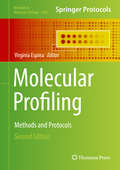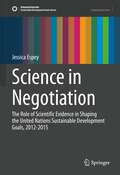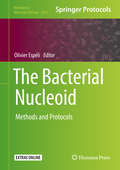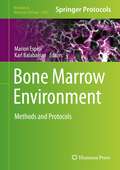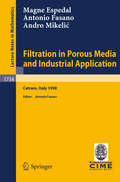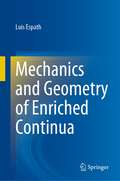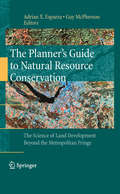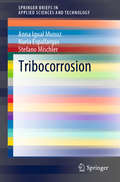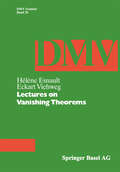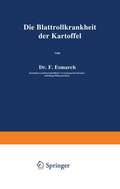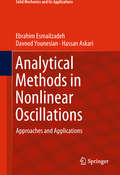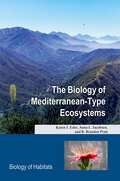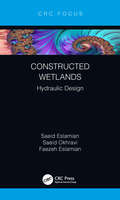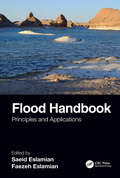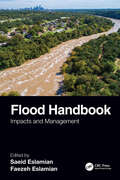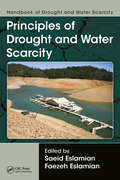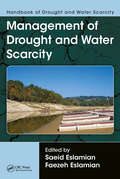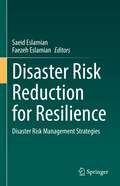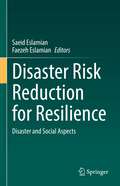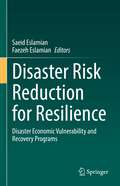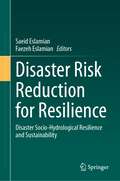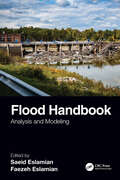- Table View
- List View
Molecular Profiling: Methods and Protocols (Methods in Molecular Biology #1606)
by Virginia EspinaThis second edition provides an update on technology and an accelerated tutorial to assist, students, entrepreneurs, new investigators, and established investigators who want to quickly become versed in, and immersed in, the entire process from discovery to clinical trial validation and commercial public benefit. Chapters aim to cover the full spectrum of molecular profiling from tumor staging and grading through biomarker discovery, to commercialization. Written in the highly successful Methods in Molecular Biology series format, chapters include introductions to their respective topics, lists of the necessary materials and reagents, step-by-step, readily reproducible laboratory protocols, and tips on troubleshooting and avoiding known pitfalls. Authoritative and practical, Molecular Profiling: Methods and Protocols, Second Edition aims to be a useful guide on molecular profiling.
Science in Negotiation: The Role of Scientific Evidence in Shaping the United Nations Sustainable Development Goals, 2012-2015 (Sustainable Development Goals Series)
by Jessica EspeyThis book explores the role of scientific evidence within United Nations (UN) deliberation by examining the negotiation of the Sustainable Development Goals (SDGs), endorsed by Member States in 2015. Using the SDGs as a case study, this book addresses a key gap in our understanding of the role of evidence in contemporary international policy-making. It is structured around three overarching questions: (1) how does scientific evidence influence multilateral policy development within the UN General Assembly? (2) how did evidence shape the goals and targets that constitute the SDGs?; and (3) how did institutional arrangements and non-state actor engagements mediate the evidence-to-policy process in the development of the SDGs? The ultimate intention is to tease out lessons on global policy-making and to understand the influence of different evidence inputs and institutional factors in shaping outcomes. To understand the value afforded to scientific evidence within multilateral deliberation, a conceptual framework is provided drawing upon literature from policy studies and political science, including recent theories of evidence-informed policy-making and new institutionalism. It posits that the success or failure of evidence informing global political processes rests upon the representation and access of scientific stakeholders, levels of community organisation, the framing and presentation of evidence, and time, including the duration over which evidence and key conceptual ideas are presented. Cutting across the discussion is the fundamental question of whose evidence counts and how expertise is defined? The framework is tested with specific reference to three themes that were prominent during the SDG negotiation process; public health (articulated in SDG 3), urban sustainability (articulated in SDG 11), and data and information systems (which were a cross-cutting theme of the dialogue). Within each, scientific communities had specific demands and through an exploration of key literature, including evidence inputs and UN documentation, as well as through key informant interviews, the translation of these scientific ideas into policy priorities is uncovered. The intended audiences of this book include academic practitioners studying evidence to policy processes, multilateral negotiation and/or UN policy planning. The book also intends to provide useful insights for policy makers, including UN diplomats, officials and staff working to improve the quality of evidence communication and uptake within multilateral institutions. Finally, it aims to support the whole global academic and scientific community, including students of public policy and political science, by providing insights on how to input into, influence, and even shape international evidence-informed policy-making.
The Bacterial Nucleoid: Methods and Protocols (Methods in Molecular Biology #1624)
by Olivier EspéliThis volume presents state-of-the-art protocols for key experiments that have revolutionized our understanding of the bacterial nucleoid. This book is divided into five parts: Part I introduces molecular genetic methods to study bacterial nucleoids; Part II highlights the study of bacterial nucleoid with whole genome analysis method; Part III discusses molecular biology methods to study nucleoid structuring factors; Part IV looks at imaging bacterial nucleoid; and Part V explores biophysics of the bacterial nucleoid. Written in the highly successful Methods in Molecular Biology series format, chapters include introductions to their respective topics, lists of the necessary materials and reagents, step-by-step, readily reproducible laboratory protocols, and tips on troubleshooting and avoiding known pitfalls. Thorough and cutting-edge, The Bacterial Nucleoid: Methods and Protocols is a valuable resource that provides a wealth of new information about this chromosome.
Bone Marrow Environment: Methods and Protocols (Methods in Molecular Biology #2308)
by Marion Espéli Karl BalabanianThis volume brings together classical and cutting-edge protocols on the spatio-temporal study of the cellular subsets constituting the bone and the marrow in both mouse and human. Chapters details methods on bone marrow (BM) ecosystem, to label, sort, analyse, and culture specific cell subsets as well as techniques allowing the evaluation of the function of some of the cellular elements of the BM. Written in the highly successful Methods in Molecular Biology series format, chapters include introductions to their respective topics, lists of the necessary materials and reagents, step-by-step, readily reproducible laboratory protocols, and tips on troubleshooting and avoiding known pitfalls. Authoritative and cutting-edge, Bone Marrow Environment: Methods and Protocols aims to help new investigators to pursue the characterization of the BM microenvironment in the coming years.
Filtration in Porous Media and Industrial Application: Lectures given at the 4th Session of the Centro Internazionale Matematico Estivo (C.I.M.E.) held in Cetraro, Italy, August 24-29, 1998 (Lecture Notes in Mathematics #1734)
by M.S. Espedal A. Fasano A. MikelicThis book is devoted to the presentation of some flow problems in porous media having relevant industrial applications. The main topics covered are: the manufacturing of composite materials, the espresso coffee brewing process, the filtration of liquids through diapers, various questions about flow problems in oil reservoirs and the theory of homogenization. The aim is to show that filtration problems arising in very practical industrial context exhibit interesting and highly nontrivial mathematical aspects. Thus the style of the book is mathematically rigorous, but specifically oriented towards applications, so that it is intended for both applied mathematicians and researchers in various areas of technological interest. The reader is required to have a good knowledge of the classical theory of PDE and basic functional analysis.
Mechanics and Geometry of Enriched Continua
by Luis EspathThis monograph presents a comprehensive and rigorous new framework for the theoretical description and modelling of enriched continua. In other words, continua that exhibit more complex behaviour than their conventional counterparts and, in particular, multicomponent systems. It employs gradient theories, exhibiting multiple transition layers described by phase fields. As a point of departure, we account for multiple continuum kinematic processes, including motion and various phase fields. These gradient theories arise by considering various kinematic processes which are tightly linked to the level of the arbitrariness of the Euler–Cauchy cuts. The surface defining the Euler–Cauchy cut may lose its smoothness along a curve, and the curve may also lose its smoothness at a point. Additionally, we postulate the principle of virtual power on surfaces. Then, the first and second laws of thermodynamics with the power balance provide suitable and consistent choices for the constitutive equations. Finally, the complementary balances, namely the balances on surfaces, are tailored to coincide with different parts of the boundaries of the body. These surface balances are then called environmental surface balances and aid in determining suitable and consistent boundary conditions. Ultimately, the environmental surface power balance is relaxed to yield an environmental surface imbalance of powers, rendering a more general type of boundary condition.A detailed introduction sets the scene for the mathematical chapters that follow, ensuring that graduate students and newcomers can profit from the material presented.
The Planner’s Guide to Natural Resource Conservation: The Science of Land Development Beyond the Metropolitan Fringe
by Adrian X. Esparza Guy McPhersonMuch of the country’s recent population growth is situated in exurban areas. By many accounts exurbanization has become the dominant pattern of land development in the country and there is no indication it will slow in the foreseeable future (Theobald 2005; Brown et al. 2005; Glennon and Kretser 2005). By definition, exurban development takes place beyond the metropolitan fringe, often in rural and remote areas. The development of new exurban communities is a growing trend, especially in the West. In this case, developers and homebuilders seek large tracts of land, up to thousands of acres, in rural areas (typically within 50 miles of a large city) where they plan entire communities consisting of commercial, retail and residential land uses. Recreational amenities such as golf courses and hiking/biking trails are often included in these master-planned developments. Our philosophy is reflected in the book’s two objectives. First, we seek to document the extent and impacts of exurban development across the country. At issue is demonstrating why planners and the public-at-large should be concerned about exurbanization. We will demonstrate that even though exurbanization favors amenity rich regions, it affects all areas of the country through the loss of agricultural and grazing lands, impacts to watersheds and land modification. A summary of environmental impacts is presented, including the loss of wildlands and agricultural productivity, land modification, soil erosion, impacts to terrestrial hydrologic systems, the loss of biodiversity, nonnative and endangered species and other topics. Our second aim is to provide readers from diverse (nonscientific) backgrounds with a working knowledge of how and why exurbanization impacts environmental systems. This is accomplished by working closely to ensure contributors follow a specific outline for each chapter. First, contributors will spell out fundamental concepts, principles and processes that apply to their area of expertise (e.g., riparian areas). Contributors will move beyond a cursory understanding of ecological processes without overwhelming readers with the dense material found typically in specialized texts. For this reason, visuals and other support materials will be integral to each chapter. We have chosen contributors carefully based on their record as research scientists and acumen as educators. Second, once the mechanics have been laid out, authors will explain how and why land development in nearby areas influences ecosystems. Issues of interdependency, modification and adaptation, spatial scale and varying time horizons will be featured. Third, contributors will weigh in on the pros and cons of various land-development schemes. Fourth, authors will share their thinking on the merits of conservation devices such as wildlife corridors, open-space requirements and watershed management districts. Finally, each chapter will conclude by identifying pitfalls to avoid and highlighting "best practices" that will mitigate environmental problems or avoid them altogether. In sum, after completing each chapter, readers should have a firm grasp of relevant concepts and processes, an understanding of current research and know how to apply science to land-use decisions.
Tribocorrosion (SpringerBriefs in Applied Sciences and Technology)
by Nuria Espallargas Stefano Mischler Anna Igual MunozThis book is a toolbox for identifying and addressing tribocorrosion situations from an engineering point of view. It is an accessible and introductory guideline to the emerging and interdisciplinary field of tribocorrosion covering the main concepts of tribology and corrosion. It describes specific tribocorrosion concepts, models and experimental techniques as well as their application to practical situations in which mechanical and chemical phenomena act simultaneously.
Reactive Oxygen Species: Methods and Protocols (Methods in Molecular Biology #2202)
by Jesús EspadaThis volume provides a varied selection of current methods and molecular probes used to generate, image and quantify ROS production and lipid peroxidation. Chapters guide readers through methods and protocols on in silico modelling of ROS dynamics in biological systems and a breaking proposal. Written in the highly successful Methods in Molecular Biology series format, chapters include introductions to their respective topics, lists of the necessary materials and reagents, step-by-step, readily reproducible laboratory protocols, and tips on troubleshooting and avoiding known pitfalls. Authoritative and cutting-edge, Reactive Oxygen Species: Methods and Protocols aims to ensure successful results in the further study of this vital field.
Lectures on Vanishing Theorems (Oberwolfach Seminars #20)
by Esnault ViewegIntroduction M. Kodaira's vanishing theorem, saying that the inverse of an ample invert ible sheaf on a projective complex manifold X has no cohomology below the dimension of X and its generalization, due to Y. Akizuki and S. Nakano, have been proven originally by methods from differential geometry ([39J and [1]). Even if, due to J.P. Serre's GAGA-theorems [56J and base change for field extensions the algebraic analogue was obtained for projective manifolds over a field k of characteristic p = 0, for a long time no algebraic proof was known and no generalization to p > 0, except for certain lower dimensional manifolds. Worse, counterexamples due to M. Raynaud [52J showed that in characteristic p > 0 some additional assumptions were needed. This was the state of the art until P. Deligne and 1. Illusie [12J proved the degeneration of the Hodge to de Rham spectral sequence for projective manifolds X defined over a field k of characteristic p > 0 and liftable to the second Witt vectors W2(k). Standard degeneration arguments allow to deduce the degeneration of the Hodge to de Rham spectral sequence in characteristic zero, as well, a re sult which again could only be obtained by analytic and differential geometric methods beforehand. As a corollary of their methods M. Raynaud (loc. cit.) gave an easy proof of Kodaira vanishing in all characteristics, provided that X lifts to W2(k).
Die Blattrollkrankheit der Kartoffel
by F. EsmarchDieser Buchtitel ist Teil des Digitalisierungsprojekts Springer Book Archives mit Publikationen, die seit den Anfängen des Verlags von 1842 erschienen sind. Der Verlag stellt mit diesem Archiv Quellen für die historische wie auch die disziplingeschichtliche Forschung zur Verfügung, die jeweils im historischen Kontext betrachtet werden müssen. Dieser Titel erschien in der Zeit vor 1945 und wird daher in seiner zeittypischen politisch-ideologischen Ausrichtung vom Verlag nicht beworben.
Analytical Methods in Nonlinear Oscillations: Approaches and Applications (Solid Mechanics and Its Applications #252)
by Ebrahim Esmailzadeh Davood Younesian Hassan AskariThis book covers both classical and modern analytical methods in nonlinear systems. A wide range of applications from fundamental research to engineering problems are addressed. The book contains seven chapters, each with miscellaneous problems and their detailed solutions. More than 100 practice problems are illustrated, which might be useful for students and researchers in the areas of nonlinear oscillations and applied mathematics. With providing real world examples, this book shows the multidisciplinary emergence of nonlinear dynamical systems in a wide range of applications including mechanical and electrical oscillators, micro/nano resonators and sensors, and also modelling of global warming, epidemic diseases, sociology, chemical reactions, biology and ecology.
The Biology of Mediterranean-Type Ecosystems (Biology of Habitats Series)
by Karen J. Esler Anna L. Jacobsen R. Brandon PrattThe world's mediterranean-type climate regions (including areas within the Mediterranean, South Africa, Australia, California, and Chile) have long been of interest to biologists by virtue of their extraordinary biodiversity and the appearance of evolutionary convergence between these disparate regions. These regions contain many rare and endemic species. Their mild climate makes them appealing places to live and visit and this has resulted in numerous threats to the species and communities that occupy them. Threats include a wide range of factors such as habitat loss due to development and agriculture, disturbance, invasive species, and climate change. As a result, they continue to attract far more attention than their limited geographic area might suggest. This book provides a concise but comprehensive introduction to mediterranean-type ecosystems. It is an accessible text which provides an authoritative overview of the topic. As with other books in the Biology of Habitats Series, the emphasis in this book is on the organisms that dominate these regions although their management, conservation, and restoration are also considered.
Cartilage: From Biology to Biofabrication
by Mohamadreza Baghaban Eslaminejad Samaneh HosseiniThis book provides a comprehensive overview of cartilage structure, functions, and approaches for the regeneration of cartilage tissue. It reviews multiple signaling pathways that are involved in the growth and repair of cartilage tissue. The initial chapter of the book examines the etiology, diagnosis, and pathological features of various cartilage diseases. Subsequently, the book presents recent advances in biomaterial sciences, regenerative medicine, and fabrication technology for cartilage regeneration. It discusses hydrogels as a promising scaffold for cartilage tissue engineering, focusing on recapitulating microenvironments present during development or in adult tissue to induce the formation of cartilaginous constructs with biochemical and mechanical properties of native tissue. Lastly, it covers the applications of 3 D printing techniques for the fabrication of scaffolds for cartilage tissue regeneration for the production of biological implants capable of treating a range of conditions.
Constructed Wetlands: Hydraulic Design
by Saeid Eslamian Saeid Okhravi Faezeh EslamianConstructed Wetlands: Hydraulic Design provides fundamental information on internal wetland hydraulic and biochemical processes, as well as practical guidance on the effective design of wetlands for water treatment. It includes the latest innovations and technological advances of constructed wetlands based on the newest technologies in the field. Features: Explains how various pollutants are either retained or removed from treatment systems Examines system geometry, flow rate, inlet-outlet configurations, and more Offers useful guidance and tools to practitioners for designing wastewater treatment structures naturally and optimally Introduces the various aspects of hydraulic engineering through porous media This book will serve as a valuable resource for practicing professionals, researchers, policy makers, and students seeking to gain an in-depth understanding of the hydraulic processes involved in constructed wetlands water treatment systems.
Constructed Wetlands: Hydraulic Design
by Saeid Eslamian Saeid Okhravi Faezeh EslamianConstructed Wetlands: Hydraulic Design provides fundamental information on internal wetland hydraulic and biochemical processes, as well as practical guidance on the effective design of wetlands for water treatment. It includes the latest innovations and technological advances of constructed wetlands based on the newest technologies in the field. Features: Explains how various pollutants are either retained or removed from treatment systems Examines system geometry, flow rate, inlet-outlet configurations, and more Offers useful guidance and tools to practitioners for designing wastewater treatment structures naturally and optimally Introduces the various aspects of hydraulic engineering through porous media This book will serve as a valuable resource for practicing professionals, researchers, policy makers, and students seeking to gain an in-depth understanding of the hydraulic processes involved in constructed wetlands water treatment systems.
Flood Handbook: Principles and Applications
by Saeid Eslamian Faezeh A. EslamianFloods are difficult to prevent but can be managed in order to reduce their environmental, social, cultural, and economic impacts. Flooding poses a serious threat to life and property, and therefore it’s very important that flood risks be taken into account during any planning process. This handbook presents different aspects of flooding in the context of a changing climate and across various geographical locations. Written by experts from around the world, it examines flooding in various climates and landscapes, taking into account environmental, ecological, hydrological, and geomorphic factors, and considers urban, agriculture, rangeland, forest, coastal, and desert areas. Features Presents the main principles and applications of the science of floods, including engineering and technology, natural science, as well as sociological implications. Examines flooding in various climates and diverse landscapes, taking into account environmental, ecological, hydrological, and geomorphic factors. Considers floods in urban, agriculture, rangeland, forest, coastal, and desert areas Covers flood control structures as well as preparedness and response methods. Written in a global context, by contributors from around the world.
Flood Handbook: Impacts and Management
by Saeid Eslamian Faezeh A. EslamianFloods are difficult to prevent but can be managed in order to reduce their environmental, social, cultural, and economic impacts. Flooding poses a serious threat to life and property, and therefore it’s very important that flood risks be taken into account during any planning process. This handbook presents different aspects of flooding in the context of a changing climate and across various geographical locations. Written by experts from around the world, it examines flooding in various climates and landscapes, taking into account environmental, ecological, hydrological, and geomorphic factors, and considers urban, agriculture, rangeland, forest, coastal, and desert areas. Features Presents the main principles and applications of the science of floods, including engineering and technology, natural science, as well as sociological implications. Examines flooding in various climates and diverse landscapes, taking into account environmental, ecological, hydrological, and geomorphic factors. Considers floods in urban, agriculture, rangeland, forest, coastal, and desert areas Covers flood control structures as well as preparedness and response methods. Written in a global context, by contributors from around the world.
Handbook of Drought and Water Scarcity: Principles of Drought and Water Scarcity
by Saeid Eslamian Faezeh A. EslamianThis volume include over 30 chapters, written by experts from around the world. It examines drought and all of the fundamental principles relating to drought and water scarcity. It includes coverage of the causes of drought, occurences, preparations, drought vulnerability assessments, societal implications, and more.
Handbook of Drought and Water Scarcity: Management of Drought and Water Scarcity
by Saeid Eslamian Faezeh A. EslamianThis volume includes over 30 chapters, written by experts from around the world. It examines numerous management strategies for dealing with drought and scarcity. These strategies include management approaches for different regions, such as coastal, urban, rural, and agricultural areas. It offers multiple strategies for monitoring, assessing, and forcasting drought through the use of remote sensing and GIS tools. It also presents drought mitigation management strategies, such as groundwater management, rainwater harvesting, conservations practices, and more.
Disaster Risk Reduction for Resilience: Disaster Risk Management Strategies
by Saeid Eslamian Faezeh EslamianThis book is part of a six-volume series on Disaster Risk Reduction and Resilience. The series aims to fill in gaps in theory and practice in the Sendai Framework, and provides additional resources, methodologies and communication strategies to enhance the plan for action and targets proposed by the Sendai Framework. The series will appeal to a broad range of researchers, academics, students, policy makers and practitioners in engineering, environmental science and geography, geoscience, emergency management, finance, community adaptation, atmospheric science and information technology. This volume offers the international guidelines and global standards for resilient disaster risk reduction and lessons learned from disasters, particularly the COVID-19 and Cholera pandemics. A resilient health system and an effective disaster risk management Index are then suggested. The book further emphasizes urban resilience strategies with local authorities, adaptation strategies for urban heat at regional, city and local scales, and lessons from community-level interventions. Also addressed are coastal erosion, displacement and resettlement strategies. Land use planning and green infrastructure are suggested as tools for natural hazards reduction. Human security in times of climate change and urban heat at regional, city and local scales is discussed for an integrated action, with case studies based in Manila, Burkina Faso, Chad, Mauritania, Niger, Senegal, Nigeria, India, Spain, and Ghana. Structure design for cascading disasters resulting from mining and flooding is presented and sustainable smart city planning using spatial data is recommended.
Disaster Risk Reduction for Resilience: Disaster and Social Aspects
by Saeid Eslamian Faezeh EslamianThis book is part of a six-volume series on Disaster Risk Reduction and Resilience. The series aims to fill in gaps in theory and practice in the Sendai Framework and provides additional resources, methodologies, and communication strategies to enhance the plan for action and targets proposed by the Sendai Framework. The series will appeal to a broad range of researchers, academics, students, policy makers, and practitioners in engineering, environmental science, geography, geoscience, emergency management, finance, community adaptation, atmospheric science and information technology.This volume provides a holistic approach to developing disaster risk reduction strategies and policies, exploring the most effective ways to integrate physical and social science aspects of hazard resilience to better inform local populations. This risk-based approach to community resilience development is used to craft a collaborative system for crisis management, and allows for the implementation of nationally determined contributions (NDCs) through social innovation and community engagement to enhance community emergency response support and preparedness. Readers will also learn about education of disaster risk reduction, human health risk assessment, gendered perspectives in disaster response, recovery, and disaster management legislation.
Disaster Risk Reduction for Resilience: Disaster Economic Vulnerability and Recovery Programs
by Saeid Eslamian Faezeh EslamianThis book is part of a six-volume series on Disaster Risk Reduction and Resilience. The series aims to fill in gaps in theory and practice in the Sendai Framework, providing additional resources, methodologies, and communication strategies to enhance the plan for action and targets proposed by the Sendai Framework. The series will appeal to a broad range of researchers, academics, students, policy makers, and practitioners in engineering, environmental science and geography, geoscience, emergency management, finance, community adaptation, atmospheric science, and information technology.This volume focuses on the concepts of economic and development vulnerability, discussing the roles of physical, social, cultural, political, economic, technological, and development factors that contribute to disaster impacts and threat levels on vulnerable populations. This approach explores how the resilience of individuals and communities can be increased in the face of future hazard threats, and how post-disaster efforts are planned for and implemented to manage risk reduction and the potential outcomes of hazard threats. Topics addressed in the boom include disaster recovery reform and resilience, recovery, and development programs, place-based reconstruction policies, resilient and sustainable disaster relief, and recovery programs, sustainable community development, and disaster recovery and post-hazard recovery strategies.
Disaster Risk Reduction for Resilience: Disaster Socio-Hydrological Resilience and Sustainability
by Saeid Eslamian Faezeh EslamianThis book is part of a six-volume series on Disaster Risk Reduction and Resilience. The series aims to fill in gaps in theory and practice in the Sendai Framework, and provides additional resources, methodologies and communication strategies to enhance the plan for action and targets proposed by the Sendai Framework. The series will appeal to a broad range of researchers, academics, students, policy makers and practitioners in engineering, environmental science and geography, geoscience, emergency management, finance, community adaptation, atmospheric science and information technology.This volume discusses the implementation of socio-hydrological resilience measures to curb the impacts on vulnerable communities of hydrologic diasters such as coastal floods, drought, water scarcity, and thunderstorms. The book provides a framework for sustainable hydrology-community interactions to inform local communities about the best practices to achieve hydrological resilience, and to implement resilient water infrastructure. Hydrological influences on the resilience of a region are comprehensively surveyed, and a "green economy strategy" is described and recommended for achieving climatic and hydrological sustainability.
Flood Handbook: Analysis and Modeling
by Saeid Eslamian Faezeh EslamianFloods are difficult to prevent but can be managed in order to reduce their environmental, social, cultural, and economic impacts. Flooding poses a serious threat to life and property, and therefore it’s very important that flood risks be taken into account during any planning process. This handbook presents different aspects of flooding in the context of a changing climate and across various geographical locations. Written by experts from around the world, it examines flooding in various climates and landscapes, taking into account environmental, ecological, hydrological, and geomorphic factors, and considers urban, agricultural, rangeland, forest, coastal, and desert areas. Features: Presents the main principles and applications of the science of floods, including engineering and technology, natural science, and sociological implications. Considers floods in urban, agricultural, rangeland, forest, coastal, and desert areas. Covers flood control structures as well as preparedness and response methods. Written in a global context, by contributors from around the world.
